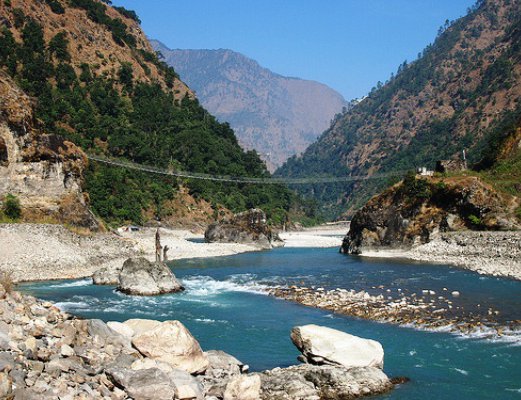
Nepal is looking forward to implement in near future very ambitious 260 meters high Burhi-Gandaki double arch dam hydropower project based on design of French engineers to resolve our energy supply problem. Everyone knows that the proposed dam is located in an area prone to big landslides, which frequently block the river resulting in impounding of entire river flow.Needless to say that absolute certainty of suitability of geological condition is a prerequisite for selection of the proposed double arch dam. Thus, the type of dam proposed for the Burhi-Gandaki project must be outright rejected if there is even a slightest possibility that the geological conditions might not be satisfactory to build this type of dam. It is obvious that due to enormity of the volume of storage reservoir the scale of the collateral damages would be too big if this dam collapsed.
Lack of thorough geological studies had resulted in failure of double arch dam even in France itself. Similarly, the Vajon dam disaster in Italy cautions us that rigorous geological studies of reservoir area are equally important.
Malpasset Double Arch Dam Failure
The Malpasset Dam was built in France for irrigation and the storage of drinking water. It waslocated in a narrow gorge of the Reyran river valley, in the Department of Var, approximately 12 km upstream of Frejus on the French Riviera. The dam was a double curvature arch dam of only 66.5 m maximum height, with a crest length of 223 m. The Malpasset dam was very small compared to the proposed mammoth 260 meters high Burhi-Gandaki high dam but both are double curvature arch dam. Themaximum reservoir capacity was only 5,600,000; however the dam failed at night in December 1959. The main cause of the dam failure was that the geological study was not thorough as explained hereinafter.
Little of the dam arch remained, and a deep trough was cut through the rock foundations on the left bank. Investigations after the accident showed that key factors in the failure of the dam were the pore water pressure in the rock, and the nature of the rock. Under the increasing
Pressure of rising water, the arch separated from its foundation and rotated as a whole about its upper right end. The whole left side of the dam collapsed, followed by the middle part, and then the right supports.
Vajont Dam Disaster due to Landslides
The Vajont Dam was completed in 1959 in the valley of the Vajont River under Monte Toc, in the municipality of Ertoand Casso, 100 km north of Venice, Italy. One of the tallest dams in the world, being 262metres high, 27 meters wide and 22.11 meters thick at the base and 191 metres wide and 3.4 meters thick at the top.[4]
In May 1962, during initial filling with the reservoir level only at 215 meters grade five earthquake was triggered. On 9 October 1963, a massive landslide caused a man-made mega tsunami in the lake in which 50 million cubic meters of water overtopped the dam in a 250 meters wave, leading to the complete destruction of several villages and towns, and innumerable deaths.
Reservoir Induced Earthquake
Reservoir induced seismicity is a well proven natural phenomenon. It is reported that there are globally over 100 identified cases of earthquakes that were triggered by reservoirs.
The tragic Sichuan earthquake of May 12, 2008 had killed an estimated 80,000 civilians and damaged innumerable structures in China. Scientists in China and the US fear that the earthquake may have been induced by the weight of the Zipingpu reservoir water. According some published information the seismologists from China’s Earthquake Bureau had warned the government back on 2000 that the project should not be built given its proximity to major fault line, yet these warnings were ignored.
In China in 1962 a 6.1 scale earthquake was triggered at completion of the filling of Xinfengjiang dam reservoir. The epicenter of the earthquake was only 1.1 km below the surface. The dam height is 105 meters and the reservoir volume 13.5 billion cubic meters. More than 18 other cases of reservoir induced seismicity have been observed in China.
The Kariba dam in Africa has caused numerous earthquakes. Among them 20 were larger than magnitude 5 on Richter scale.
Prediction of Next Big Earthquake
It is very important to pay special attention to reservoir induced seismicity in the context of our country’s 2015 earthquake. The researchers from UK’s Center for the Observation and Modelling of Earthquakes, as well as academics from the USA and France have demonstrated that the rupture on the fault stopped 11 km below Kathmandu. They are predicting based on analysis of remote sensing maps the possibility of yet another devastating earthquake in near future because during the 2015 big earthquake the underlying tectonic plates were only partially ruptured releasing just a portion of the accumulated energy.It is equally possible that the accumulated energy might be slowly dissipated over a very long period triggering many small earthquakes. Unfortunately the Burhi-Gandaki storage reservoir might hasten to trigger another big earthquake precipitating Kathmandu and its adjoining districts into great destruction as a result of reservoir induced earthquakes.
A Panel of Internationally Renowned Experts
The Burhi-Gandaki project, that would be impounding a vast reservoir of about five billion cubic meters, would be dreadful curse to our country if the dam collapsed. Thus it is absolutely necessary that our government should constitute a panel of internationally renowned experts to review rigorously all aspects of Burhi-Gandaki project dam design to ensure that it is safe to build the proposed dam before taking final decision to implement this technically ambitious high dam project. We should not forget the fact that even then West German government had also constituted a panel of renowned experts under a French professor, who was chairman of the World Federation of Engineering Geology, to review the design of our Kankai high damdone under their grant assistance by very experienced German consulting firm although the height of that dam was only about 80 meters.

Dr. A.B. Thapa
Thapa writes on water resources issue
- Dudhkosi Multipurpose Project
- Jul 11, 2022
- Dudh-Kosi Power Project And Kosi Treaty
- Sep 27, 2021
- Uttarakhand Glaciers And Recent Disaster: A Lesson To Our Country
- Mar 02, 2021
- Multipurpose Langtang After Melamchi: Inter-Basin Water Transfer
- Nov 04, 2020
- Large Storage Dams Projects Wary of Giving Away Children’s Inheritance
- Dec 22, 2019
















